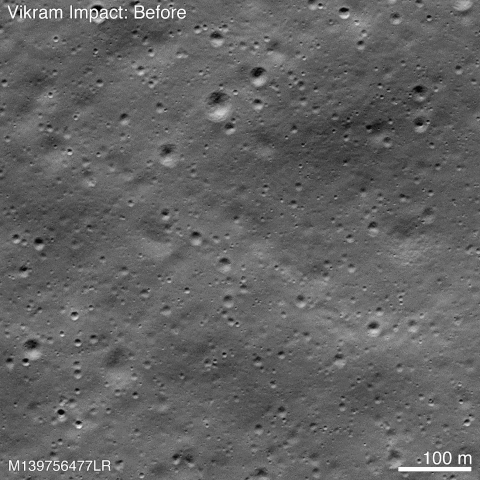
Vikram began its descent at 20:08:03 UTC, 6 September 2019 and was scheduled to land on the Moon at around 20:23 UTC. The descent and soft-landing were to be performed by the on-board computers on Vikram, with mission control unable to make corrections.[134] The initial descent was considered within mission parameters, passing critical braking procedures as expected, but the lander's trajectory began to deviate at about 2.1 km (1.3 mi) above the surface.[135][136] The final telemetry readings during ISRO's live-stream show that Vikram's final vertical velocity was 58 m/s (210 km/h) at 330 m (1,080 ft) above the surface, which a number of experts noted, would have been too fast for the lunar lander to make a successful landing.[35][137][138] Initial reports suggesting a crash[37][38] were confirmed by ISRO chairman K. Sivan, stating that "it must have been a hard landing".[39][139][140] However, it contradicted initial claims from anonymous ISRO officials that the lander was intact and lying in a tilted position.[141][142]
Radio transmissions from the lander were tracked during descent by analysts using a 25 m (82 ft) radio telescope owned by the Netherlands Institute for Radio Astronomy. Analysis of the doppler data suggests that the loss of signal coincided with the lander impacting the lunar surface at a velocity of nearly 50 m/s (180 km/h) (as opposed to an ideal 2 m/s (7.2 km/h) touchdown velocity).[3][143] The powered descent was also observed by NASA's Lunar Reconnaissance Orbiter (LRO) using its Lyman-Alpha Mapping Project instrument to study changes in the lunar exosphere due to exhaust gases from the lander's engines.[144] K. Sivan, tasked senior scientist Prem Shanker Goel to head the Failure Analysis Committee to look into the causes of the failure.[145]

Both ISRO and NASA attempted to communicate with the lander for about two weeks before the lunar night set in,[103][146] while NASA's LRO flew over on 17 September 2019 and acquired some images of the intended landing zone.[147] However, the region was near dusk, causing poor lighting for optical imaging.[148][149] NASA's LRO images, showing no sight of the lander, were released on 26 September 2019.[131] The LRO flew over again on 14 October 2019 under more favorable lighting conditions,[150][151] but was unable to locate it.[152][153] The LRO performed a third flyover on 10 November 2019.[152]
On 16 November 2019, the Failure Analysis Committee released its report to the Space Commission, concluding that the crash was caused by a software glitch.[40] Phase One of descent from an altitude of 30 km to 7.4 km above the Moon's surface went as intended with velocity being reduced from 1683 m/s to 146 m/s. But velocity during the second phase of descent was more than expected. This deviation from nominal velocity reduction was beyond the designed parameters of on-board software,[154] causing Vikram to land hard, though it managed to impact relatively near the intended landing site.[155] The complete findings have not been made public.[156][157][158]

Vikram's impact site was located at 70.8810°S 22.7840°E by the LROC team after receiving helpful input from Shanmuga Subramanian, a volunteer from Chennai, Tamil Nadu, who located debris from the spacecraft in pictures released by NASA.[159][160] While initially estimated to be within 500 m (1,600 ft) of the intended landing site, best-guess estimates from satellite imagery indicate initial impact about 600 m away.[161] The spacecraft shattered upon impact,[162] with debris scattered over almost two dozen locations in an area spanning kilometres.[160]
The orbiter part of the mission, with eight scientific instruments, remains operational, and will continue its seven-year mission to study the Moon.[136]


